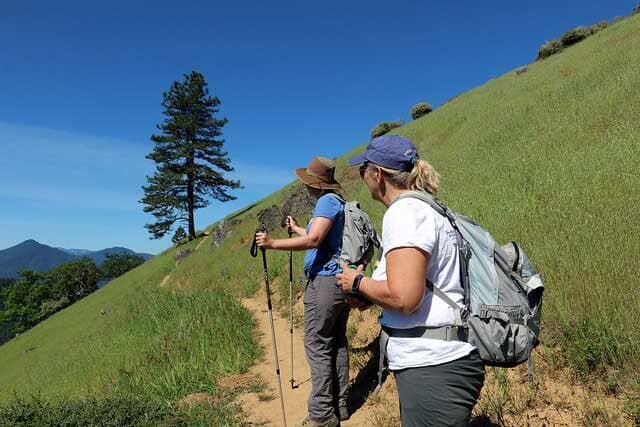There are all kinds of benefits on a hiking holiday.
As we discussed previously on this site, with the exercise and fresh air associated with hiking, you will feel the health benefits. You will get to take in some beautiful scenery too, with an up close and personal look at the nature and wildlife around you. And you might get to meet other hikers on your holiday, be that at the campsite you base yourself at, or on the trails you are walking on. As a consequence, you might make new friends, and in conversation, you might hear about other must-see hiking destinations that you should try in your lifetime.
And this is all well and good, but to ensure you make the most of your holiday, you do need to stay safe! After all, you don’t want to injure yourself when you’re in a remote location, despite the exciting prospect of being whisked away by an air rescue helicopter to a hospital.
Safety Tip #1: Ensure you have the right gear
It shouldn’t need to be said, but you need walking boots and not a pair of trainers when you’re hitting the trails. You need to bring your waterproofs too, as well as warm clothing in the event temperatures turn cold. For walking support, you need to research the best walking sticks, and to ensure you don’t get lost en route, you should also bring a compass and a map. Other must-have items include bottles of water for refreshment and hydration purposes, and extra food to keep you energized on your trip. Without any of these items, you are putting your life in danger, as losing your footing, getting lost, or becoming dehydrated, could have unpleasant consequences for you.
Safety Tip #2: Research the trail you intend to walk on
If you are exploring somewhere new, it is always worth putting in the research first. You will then be mentally prepared for the challenge ahead, and you will be alert to any areas that might be deemed unsafe. Check the terrain on Google Maps or download an app that will help you explore the area you are traveling to ahead of time. We especially like Topo Maps, as not only does it give you the means to check out walking trails, but it also acts as a map and GPS, even when you aren’t in range of a cell phone service tower. After checking the trail, consider your limits. If you think it is too difficult for you, look for somewhere else to walk. This is better than pushing yourself and running into difficulty on your hike.
Safety Tip #3: Check the forecast
In some instances, it might be safer to stay in your tent than begin your expedition. If there are high winds expected, for example, or if there is a chance of snow or heavy rain, you might not want to take the risks associated with such conditions. It depends on the trail you are taking, so be sensible and think logically before heading out on your journey. Checking the forecast will also give you the means to plan what you are going to wear, although you should still bring alternative clothing, just in case the weather changes unexpectedly.
Safety Tip #4: Let somebody know where you’re going
Contact a friend or family member and give them your itinerary. Let them know where you are going each day and when you expect to be back at your base. And then arrange to drop them a text to let them know you’re safe after returning. If they don’t hear from you at the expected time, then this might alert them to the fact that you could be in trouble. They will then have the impetus to call or text you, and if they get no reply, they should then call a local rescue service to check up on you.
Finally
A hiking holiday can be highly enjoyable, but if you put your safety at risk, it might also become your worst nightmare. Follow our suggestions then to make sure you have a wonderful and safe time while you’re away.
Photo Credit: https://www.flickr.com/photos/blmoregon/40237270420














